| Reviews & Columns |
|
Reviews DVD TV on DVD Blu-ray 4K UHD International DVDs In Theaters Reviews by Studio Video Games Features Collector Series DVDs Easter Egg Database Interviews DVD Talk Radio Feature Articles Columns Anime Talk DVD Savant Horror DVDs The M.O.D. Squad Art House HD Talk Silent DVD
|
DVD Talk Forum |
|
|
| Resources |
|
DVD Price Search Customer Service #'s RCE Info Links |
|
Columns
|
|
|
From the Earth to the Moon - The Signature Edition
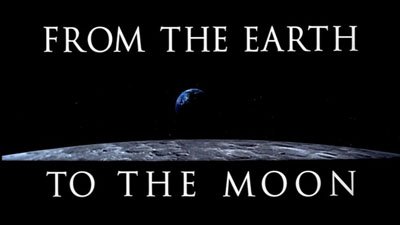
INTRODUCTION:
On May 25, 1961, President John F. Kennedy addressed a joint session of Congress and outlined a plan for one of our nation's most ambitious endeavors: landing a man on the moon and returning him safely to the earth by the end of the decade. To that point, Americans had logged barely 5 minutes in weightless space, so the proposition of putting a man on the moon in under 9 years would be a staggering feat that could only be accomplished through the efforts of hundreds of thousands of dedicated individuals all striving for one common goal. When Neil Armstrong ultimately stepped out of the Lunar Module "Eagle", and the dream was finally realized, the world watched in awe at the demonstration of just how much humanity could accomplish when united in the task.
A quarter century after budgetary cuts concluded the Apollo program that send mankind to the moon, Tom Hanks, Imagine Entertainment, and HBO teamed up to bring the entire story to life on television. Assembling a ridiculous amount of talent, both in front of and behind the camera, and maintaining a strict attention to detail with the help of NASA, they spent 3 years and over 65 million dollars turning the pinnacle of human achievement into arguably the best television miniseries ever made and the definitive dramatic account of this remarkable period of history. Originally released on DVD in 1998 in an expensive box set, HBO now releases it once more under the title "From the Earth to the Moon - The Signature Edition".
CONTENT:
When President Kennedy stood before Congress and requested the funds to finance the journey to the moon, he stated, "Let it be clear that I am asking the Congress and the country to accept a firm commitment to a new course of action, a course which will last for many years and carry very heavy costs. If we are to go only halfway or reduce our sights in the face of difficulty, in my judgment it would be better not to go at all." The same could be said for the effort to produce this miniseries. Helmed by self-proclaimed "space nut" Tom Hanks and assisted by Gemini and Apollo veteran David Scott, accuracy and attention to detail were of paramount importance (with some necessary dramatic license), and the producers recognized that if they were to attempt this undertaking, it had to be done correctly and completely. The result is nothing short of spectacular.
From the Earth to the Moon is presented in 12 hour-long installments, and perhaps even more impressive than the realistic special effects and powerful performances is the clever and effective organization to the storytelling. Each episode takes a completely different approach than the one before it, telling its own unique story in the evolution of America's space program, while at the same time maintaining a clear linear progression throughout the series from Kennedy's speech to the final moments of Apollo 17. The structure is such that while the viewer follows along with the timeline of events, each hour is a production unto itself, revealing a new layer to the story and providing additional depth of understanding to the journey as a whole. From the Earth to the Moon isn't just the story of the astronauts and their missions; it's also the story of the countless unheralded men and women whose different and important contributions made the journey possible. Each hour opens with a short introduction from Tom Hanks, who sets the stage for the upcoming drama by placing the episode in its relevant historical context.
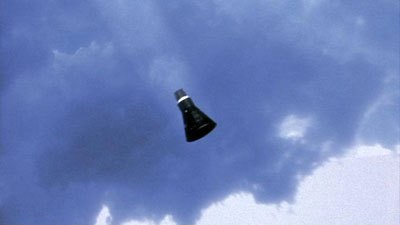
Part 1: Can We Do This?
"If we had gotten Shepard into space before Gagarin, it would be over. We'd have beaten them, and that would be that."
- NASA Administrator James Webb
Noble pursuits are often inspired by less-than-noble motivations, and such was the case with the race to the moon. On April 12, 1961, the Russians sent the first man into space when cosmonaut Yuri Gagarin made a full orbit around Earth. America had yet to even get a man into space, let alone into orbit. We were behind, and the world was watching. In order to eclipse the Russians and take charge of the space race, a goal had to be set far enough in advance to give us time to catch up. One suggestion was to build a space station, but it was believed that the Russians were too far ahead in the necessary research and would likely maintain that lead throughout the process. The moon, however, was not only ambitious enough, but it carried with it the romanticism necessary to inspire a nation.
"Can We Do This?" focuses on some of the decision making that led to Kennedy's challenge as well as the numerous small steps that had to be completed before even thinking about Apollo missions. It starts with Alan Shepard's historic 15-minute flight (Mercury Redstone 3 aka "Freedom 7") and then effectively sidesteps most of the Mercury program -- wonderfully captured already in The Right Stuff (1983) -- in favor of some of the more landmark Gemini missions that lead up to Apollo. There is a lot of ground to cover, as Mercury and Gemini span a good 7 years, but under the direction of Hanks, it all fits together seemlessly and makes for a perfect introduction to the series and many of the key characters in this tale.
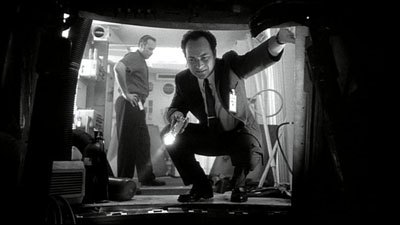
Part 2: Apollo One
"How are we going to get to the moon if we can't talk between two or three buildings?" - CDR Virgil "Gus" Grissom
After three successful unmanned tests of the Saturn 1B launch vehicle with the Command and Service Module, AS-204 was to be the first manned Apollo mission, but an unexpected tragedy almost derailed the program entirely when Gus Grissom, Edward White, and Roger Chaffee lost their lives in a fire during a preflight test of the Command Module. Taking its name from the designation this failed mission would forever be known as, "Apollo One" seeks not only to show the anatomy of the disaster but also the aftermath and intense scrutiny the program faced as a result. How did this happen, and what should be done about it?
One of the best episodes in the series, "Apollo One" captures the heart and the purpose of those involved with the program while still educating the viewer on how this disaster could happen and just how much was learned because of it. It's likely that without the lessons learned from the tragedy of Apollo 1, we never would have made it to the moon at all. Anchoring this episode are wonderful performances from Kevin Pollack (Apollo Program Manager) and James Rebhorn (VP of North American Aviation) as the two men who faced the largest emotional burden after the disaster.
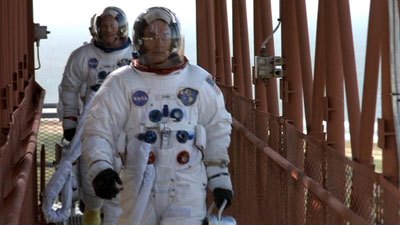
Part 3: We Have Cleared the Tower
"We're all test pilots. We're accustomed to things going wrong at times. You're sad, you mourn the loss, but you don't wear the black armband forever." - CDR Walter M. Schirra, Jr.
One of many different storytelling approaches, "We Have Cleared the Tower" takes the perspective a documentary film crew chronicling the events of Apollo 7, the mission that would follow the ill-fated Apollo 1. The pretest fire had set the program back nearly two years as the Command Module had to be redesigned and new safety measures had to be implemented. While there were 6 successful unmanned test flights sandwiched in to be absolutely sure the problems had been addressed, anxiety was at an all time high as the future of manned spaceflight rested on this mission.
Using this documentary approach, we learn more than just biographies of the men of Apollo 7 and their mission details, but we follow the film crew into discussions with Pad Leader Guenter Wendt (Max Wright) and the specifics of the safety precautions at the launch site. The documentary crew also interviews nurses and computer programmers assigned to the mission, bringing insight and perspective with regard to the countless individuals on the ground responsible for a successful voyage.
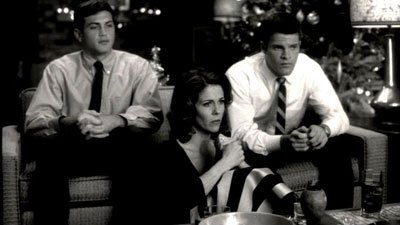
Part 4: 1968
"When it is dark enough, you can see the stars ..." - Charles A. Beard
"1968" takes yet another approach to storytelling and is shot almost entirely in black-and-white as it focuses heavily on the tumultuous events of 1968. With all the events of that year -- the assassinations of Martin Luther King, Jr. and Robert F. Kennedy, the war in Vietnam, and the riots at the Chicago Democratic Convention -- national morale was at one of the lowest points in history. Spirits at NASA weren't much better, as it became clear that the Soviets would have an unmanned vehicle to the moon first. The solution to leap-frogging them was to bump up the mission priorities and send a manned crew into orbit around the moon for Apollo 8.
This episode is as much about Apollo 8's mission as it is the social and political unrest in the country at the time. To properly understand history, you need not just examine the specific events that happened, but the context in which those events occurred, and "1968" does an excellent job capturing the emotions of a nation unsure of itself and its future. It also features a surprisingly strong performance from Hanks' wife Rita Wilson as the nervous spouse of Apollo 8 Commander Frank Borman.
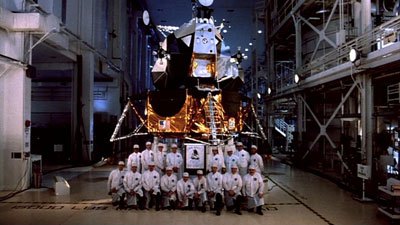
Part 5: Spider
"When I first saw the LEM, I thought, 'you gotta be kidding,' but it really is a beautiful machine." - CDR James McDivitt
Narrated by Tom Kelly (Matt Craven), lead engineer at Grumman Aircraft Engineering, "Spider" shifts from the tense dramatic tone of the previous two episodes and brings a light adventurous spirit to the series. In September of 1962, Grumman was awarded the contract for the Lunar Excursion Module (LEM), and they spent the next 7 years designing and building the transport vehicle that would ultimately allow man to set foot on the moon. Perhaps my favorite episode of the series, "Spider" beautifully captures not only the design engineering but the sweat and tears that went into creating one of the key components of Apollo.
Matt Craven is well cast in the lead role, and he hits every note perfectly as a man fully aware of the incredibly daunting task before him. Graham Yost -- who would later work on another definitive historical miniseries, Band of Brothers -- directs the episode with a wonderful mix of heart and humor and appreciation for the men and women behind the scenes (even borrowing Elmer Bernstein's iconic theme from The Great Escape). The execution is near perfect, from the genesis of lunar orbit rendezvous as a concept to the LEM's first manned orbits in Apollos 9 and 10, and it serves as an excellent precursor to LEM-5's ultimate mission in the upcoming episode.
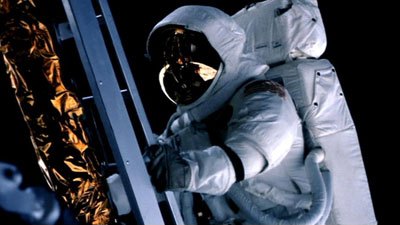
Part 6: Mare Tranquilitatis
"Walking on the moon will be a tangible achievement, but what it will represent is where all mankind is right now and what we can do if we put to use the great gifts that we've been given."
- LMP Edwin E. "Buzz" Aldrin, Jr.
Mission objectives and crew assignments were subject to so many factors beyond the control of the astronauts, and the crew that would ultimately be first to land on the moon would not be hand-picked so much as the beneficiary of fortunate circumstances. As the Apollo program unfolded, Neil Armstrong (Tony Goldwyn) and Buzz Aldrin (Bryan Cranston) found themselves in the enviable position that everyone wanted, piloting the LEM to the surface of the moon and walking on its surface. The historical significance could not be quantified or even comprehended, and while the crew was intent on executing the mission objectives to perfection, one question still had to be answered: who gets out first?
"Mare Tranquilitatis" shows a more human and vulnerable side to the unflappable astronauts as the moment of truth approaches. While Armstrong seems entrenched in the mission objectives, Aldrin is keenly aware of its historical significance, and understandably, he wants to be the guy to make that first step. Conversely, the importance of the event weighs heavily on him, almost to the point of not wanting to go at all, and we follow his emotional journey alongside Apollo 11. Of all the episodes, this one focuses most prominently on the mission specifics of this landmark flight. The events of July 20, 1969 are seared into the consciousness of everyone who witnessed it through that static-filled television signal, so recreating that drama and awe and wonder is a daunting task. "Mare Tranquilitatis" succeeds.
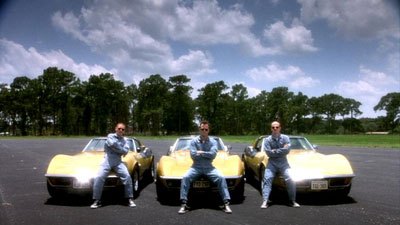
Part 7: That's All There Is
"We were the 2nd mission to land on the moon: history's ultimate anticlimax." - LMP Alan L. Bean
Taking a step back from the drama once more, "That's All There Is" is another lighthearted episode but with a completely different tone than "Spider". Al Bean (Dave Foley) narrates the story as a wide-eyed rookie assigned with veterans Charles "Pete" Conrad (Paul McCrane) and Richard Gordon (Tom Verica) on the crew of Apollo 12. Missions last for many days, and there is so much more to do than simply stepping out onto the lunar surface and waving to the camera. "That's All There Is" focuses on some of the less glamorous tasks as well as some of the pranks and mistakes made by the astronauts when the world isn't watching. The episode is so light in tone that one might question is factual accuracy, but according to a conversation I had with Dick Gordon recently, it is the most accurate, in terms of detail as well as spirit, of the entire series.
"That's All There Is" also spends considerable time on the relationship astronauts have with each other. Countless hours spent side-by-side creates a bond unlike any other, and this 7th episode in the series takes a step back to look at that unique friendship among crewmates. Like Apollo 12's actual mission, "That's All There Is" is an anticlimax to the events of "Mare Tranquilitatis", but in the case of the episode, the producers know this in advance and have fun with it.
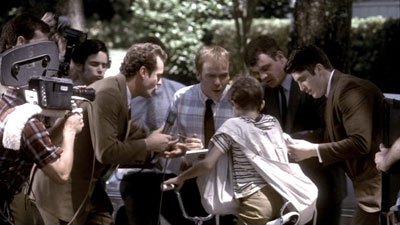
Part 8: We Interrupt This Program
"You think American wants to know about PC burns and passive thermal rolls? That's not news. That's Sominex." - Brett Hutchins
By Apollo 13, going to the moon had become "routine" in the eyes of the public, and the sense of awe and wonder over spaceflight was starting to fade. Everything changed, however, when Lovell uttered his oft misquoted phrase, "Houston, we've had a problem." What was previously a routine mission to the moon was now a story of impending human disaster, and the press jumped on it with a frenzy. The events of Apollo 13 had been previously chronicled in detail in the 1995 feature film of the same name, so "We Interrupt This Program" takes a different approach and focuses almost entirely on the media circus at home.
Having established fictional veteran anchorman and on-air NASA expert Emmett Seaborn (Lane Smith) throughout the series, we now follow his steps as he seeks to cover this national story. We also follow Brett Hutchins (Jay Mohr), an up and coming young reporter whose sense of journalistic ethics differs from Seaborn's. Neither of these two people existed in real life, and this is the only episode of the 12 that is almost entirely fictional, but the story told here is emblematic of the culture surrounding the event, and it provides quite a bit of insight into the political relationship between the government the press and NASA.
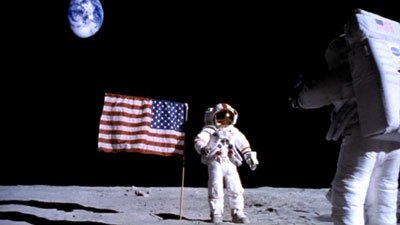
Part 9: Miles and Miles
"It's been a long way, but we're here." - CDR Alan B. Shepard, Jr.
Al Shepard (Ted Levine) was the first American to go into space, but during the Gemini program, he was diagnosed with Meniere's Disease and removed from flight status. Much like his good friend Deke Slayton (Nick Searcy), his health would likely prevent him from ever walking on the moon. Still, he remained at NASA serving as Chief of the Astronaut Office, developing training programs and evaluation procedures for the pilots, until experimental corrective surgery repaired the problem in his inner ear and offered him the opportunity to command an Apollo mission. Apollo 14's mission picks up where Apollo 13 had failed, the Fra Mauro formation, but like all the episodes in this series, it's about more than the mission itself, but the events leading up to it and the men involved in its execution.
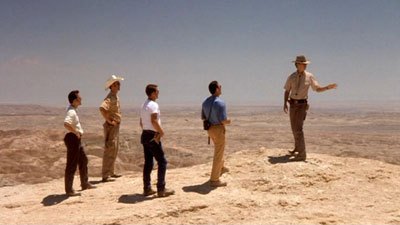
Part 10: Galileo Was Right
"You have to become our eyes and ears out there." - Dr. Lee Silver
"Galileo Was Right" rivals "Spider" as one of the best entries in the series. American astronauts were renaissance men. Not only were they top test pilots, but they were incredibly intelligent engineers and experts in numerous fields. Still, no matter how much expertise they had, there was always more to learn. In total, only 12 men would ever walk on the moon, and they would spend not more than a few hours on the surface at a time. For the voyage to be valuable, they couldn't just sightsee; they had to return to Earth with the most complete picture of the moon as humanly possible. To do that, they had to be trained in numerous specialized disciplines, including geology and cartography.
David Clennon delivers an inspiring performance in this episode as Dr. Lee Silver, the geologist who teaches the crew of Apollo 15 how to properly and accurately describe the lunar landscape to the geologists back home as well as figure out which samples are the most meaningful to collect for analysis. "Galileo Was Right" is another wonderful reminder of just how much effort went into the planning of these Apollo missions and the countless civilians who made the endeavor worthwhile.
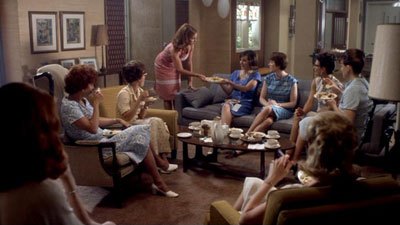
Part 11: The Original Wives' Club
"When did our kids have their tonsils out?" - CDR James Lovell
Unheralded for their sacrifices but frequently in the public spotlight were the astronauts' wives, and the space program took its toll on their marriages. "The Original Wives' Club" is a good choice for the penultimate episode, as we've grown to know most of the astronauts involved in the program and can more easily place into context the stories of their wives. This 11th episode doesn't give us the story of every wife in the program, but it does show us many of the different challenges they faced with a specific emphasis on the wives of the "New Nine". Only 2 of the marriages survived Apollo, and this episode is an effective explanation of why.
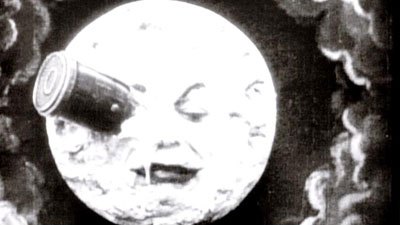
Part 12: Le Voyage Dane La Lune
"Imagining that it could be done was the very first step taken in the journey from the earth to the moon." - Blythe Danner (Narrator)
The final episode of the series is perhaps the most unique. Written by Hanks himself, it follows two parallel paths, that of the dismantling of the Apollo program and its final voyage to the moon in addition to the tale of visionary French director George Melies (Tchéky Karyo). In order to create his 1902 silent masterpiece, Melies had to invent the techniques he used along the way. Double exposures, dissolves, fades, split screens: he pioneered numerous techniques to bring his film to fruition. The space program was the same way. When Kennedy made his historic speech, no one knew how to send a man to the moon and bring him back, but along the way they pioneered and invented new technologies in incremental steps until it was possible. "Le Voyage Dane La Lune" takes a look back at the program as a whole and helps put into perspective just what was accomplished and what it took to get there. While the parallel between Melies and Apollo can be disorienting at times, the ultimate resolution of the series is powerful and moving, and it helps bring closure to this remarkable period of Earth's history.
When budget cuts ended Apollo's run, 6 missions had made it to the moon, and 12 men had walked on the lunar surface. The effort to get them there and the enormity of the task almost defies description. That From the Earth to the Moon captures so much of it so well is a remarkable accomplishment and one of those truly great pieces of television history that validates the medium as something powerful and important. With brilliant performances and staggeringly good special effects, this miniseries is not just an educational record of the events that took place, but it is a moving and awe-inspiring production of the absolute highest caliber. With the possible exception of Band of Brothers (2001), From the Earth to the Moon is by far the best miniseries ever produced for television and without a doubt one of the finest pieces of entertainment to air in my lifetime.
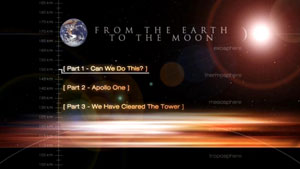
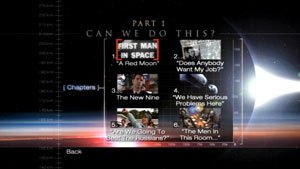
PRESENTATION:
"From the Earth to the Moon - The Signature Edition" boasts some notable changes from the original release. First, the episodes have been spread across 4 discs (3 per disc) instead of 3 (4 per disc), which increases the average bitrate per episode from around 4.5 Mb/s to closer to 6.0 Mb/s. A 5th disc contains the limited special features. These 5 discs are housed in a 5-panel folding cardboard case (that is about a third less bulky than the original release) that sits inside a larger decorative enclosure with a removable top and a glossy image that flips between the earth and the moon depending on the angle of view.
The discs themselves are organized in a nice way, and each episode fortunately has its own title on the disc (versus the original release where they are grouped in twos). Chapter selections are available for each title, but regrettably, there are no chapter stops directly after the opening credits. However, I must admit that while Michael Kamen's score reuses a few too many horn progressions from his work on Robin Hood: Prince of Thieves, I could watch the title sequence on continuous loop for hours at a time. Still, appropriate chapter stops would have been nice.
New audio has been added to the set, and it contains English DTS, English 5.1, English 2.0, French 2.0, and Spanish 2.0. While the audio presentation is perfectly fine, I'm not sure the DTS addition serves any purpose other than something to promote in the new release. Commenting specifically on the surround audio, the dialogue is clear, and the surround channels are used sparingly but effectively.
English, French, and Spanish subtitles are also included.
Now to the odd part. The primary force behind this updated release is apparently the brand new anamorphic widescreen transfer. Widescreen is great and anamorphic is essential ... when it's the correct ratio. I've read that during the filming of the miniseries, it was understood that it would one day be presented in widescreen, so shots were framed with both aspect ratios in mind, and therefore the open matte version that aired on HBO and was subsequently released to DVD in 1998 should not be superior to the widescreen version in this "Signature Edition". Oh, how I want to believe that. Clearly, there is cropping in both versions, but I'll let you decide:
| 1998 Release | 2005 Release |
|---|---|
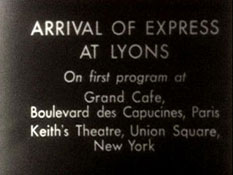 | 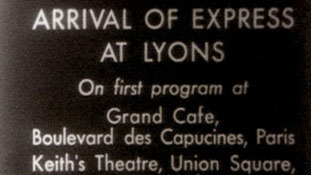 |
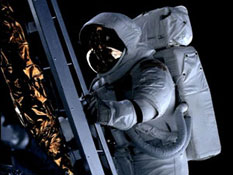 | 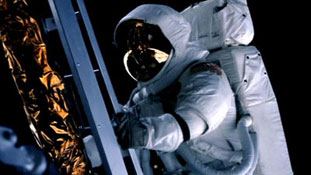 |
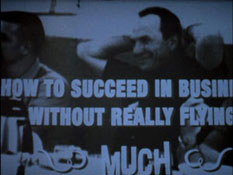 | 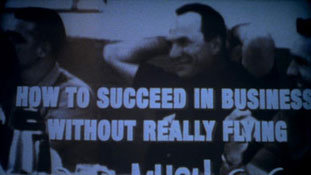 |
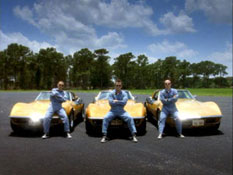 | 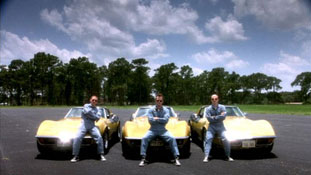 |
Further confusing the issue is the quality of the transfer. In many cases, the color quality and level of detail are superior in this new version -- scenes that were a bit faded and washed out are often more clear and realistic in the updated transfer -- but it is certainly a mixed bag, as there are numerous scenes where the original appears preferable. The updated color balance isn't always up to HBO's typical DVD standards, and there are scenes in certain episodes where the red seems pushed too far. Also, there are more than a few defects in the transfer itself as well as more dirt than should be expected from such a modern release. The video quality is arguably an improvement over the 1998 release, but it is a mild one at best.
WHISTLES & BELLS:
On the 5th disc are two featurettes. The newly titles "Behind the Scenes" featurette runs 29:31 and is the exact same as the "HBO First Look" on the original release. It is a series of interviews with some of the cast and crew and plays more like a promotional piece than a documentary on the production. "Special Effects" runs 4:08 and is also the same as the one on the original release. It is a very brief overview of how the special effects were created. Neither is particularly illuminating.
There are also 6 promotional trailers totaling about 5 minutes and excerpts from the text of President Kennedy's speech on May 25, 1961 (with an incredibly brief audio excerpt). Finally -- yes, that's it -- finally, there are some mildly educational sections called "The Space Race Timeline", "The History of the Moon", "Out of This Solar System", and "Famous Astronomers" that allow you to navigate through menus that describe various aspects of the space race.
CONCLUDING THOUGHTS:
From the Earth to the Moon is one of the finest things to ever air on television, and with the exception of Band of Brothers, is the greatest miniseries ever made. In every way, it captures the awe and wonder and struggle and triumph of mankind's journey to the moon. It is impossible to overstate the quality of this production, and it should be an essential piece of everyone's DVD library. However, as best I can tell, this "Signature Edition" means that you get a cardboard sleeve around the boxed set with a preprinted signature from Tom Hanks. There are no new special features of significant note, and while the picture quality is a slight improvement, many will argue that the anamorphic widescreen transfer is actually inferior to the original release. You absolutely must own one of these two releases, but if you already own the 1998 release, the case for "upgrading" is weak. However, if you are just now getting around to owning this remarkable piece of work, which one you buy is really up to you. It is terribly unfortunate that this "Signature Edition" is simply an alternative instead of a definitive substitute, so while From the Earth to the Moon warrants 5 stars in terms of its quality of content, I can do little more than split the difference and simply Recommend this DVD release.
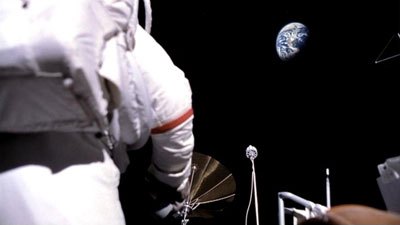
|
| Popular Reviews |
| Sponsored Links |
|
|
| Sponsored Links |
|
|
| Release List | Reviews | Shop | Newsletter | Forum | DVD Giveaways | Blu-Ray | Advertise |
|
Copyright 2024 DVDTalk.com All Rights Reserved. Legal Info, Privacy Policy, Terms of Use,
Manage Preferences,
Your Privacy Choices | |||||||














